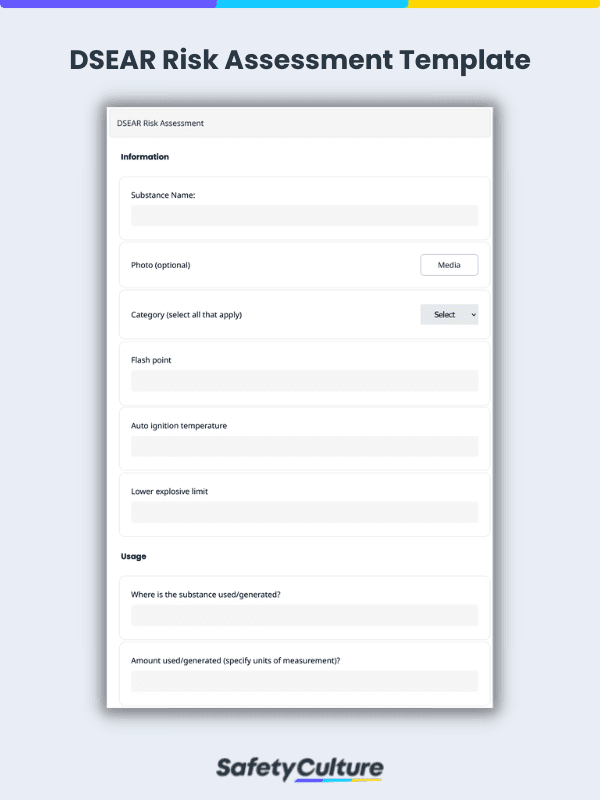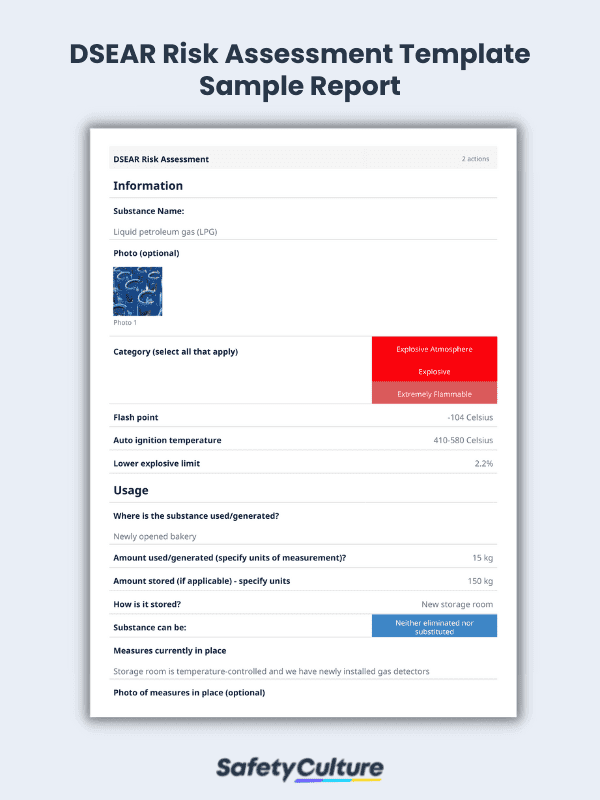What is a DSEAR Risk Assessment Template?
A DSEAR risk assessment template is a tool used by safety officers to identify, assess, and control safety risks that can lead to fires, explosions, and metal corrosion caused by hazardous substances in the workplace. This way, organizations can protect their workers from hazards when handling these materials and adhere to the Dangerous Substances and Explosive Atmospheres Regulations (DSEAR) 2002.
What is DSEAR?
The Dangerous Substances and Explosive Atmospheres Regulations (DSEAR) 2002 is a UK law that requires employers to control and mitigate workplace risks of fire, explosion, and metal corrosion caused by hazardous substances. Applicable to workplaces where dangerous substances are stored, used, or produced, failure to comply with DSEAR can lead to costly fines and work-related injuries.
What is a DSEAR Risk Assessment, and Why is it Important?
A DSEAR risk assessment refers to the process of examining the risks associated with the dangerous substances present in the workplace. It involves determining and assessing these materials, the activities they’re used in, and the risks they pose to workers.
Performing this risk assessment allows organizations to establish control measures to eliminate or control them and their effects. It also lays the groundwork for developing action plans to handle substance-related accidents, emergencies, and incidents. Lastly, the UK’s Health and Safety Executive (HSE) requires this process to be a part of DSEAR compliance.
How to Assess Risks Using a Template
As mentioned earlier, a risk assessment is a must for ensuring workplace safety and complying with DSEAR regulations. To speed up this process, organizations can take advantage of digital DSEAR templates. This section will walk you through the important steps when using this template for analyzing risks:
1. Identify the Dangerous Substance in the Workplace
Start the risk assessment process with the basic details about dangerous substances in the workplace. It should contain the following information:
- Substance name
- Category (Explosive atmosphere, explosive, extremely flammable, highly flammable, flammable, oxidizing)
- Flash point (in °C/°F)
- Auto-ignition temperature (in °C/°F)
- Lower explosive limit (in %)
2. Determine How the Substance is Used
After providing basic information about the substance, the next thing to do is to figure out how it’s utilized in business activities. For this step, it’s vital to identify the:
- Source of the dangerous substance
- Amount used in daily operations
- Storage location and the amount stored (if applicable)
- Ignition sources
- Employees at risk
In this portion, it’s also best to determine if the substance can be removed, substituted with a less harmful alternative, or neither. This allows safety officers to note any measures established to keep their employees safe and the relevant training programs for handling these materials.
3. Assess the Risks Associated with It
Once you have discovered how the substance is used and/or stored in the workplace, you can proceed with examining the risks involved with them. Begin by identifying the risk type of the substance, such as (but not limited to):
- Bulk storage of flammable liquids
- Flammable liquid storage in containers
- Hand painting with flammable liquids
- Spraying with the flammable liquids
- Handling of flammable solids
- Dust collection system
- Sources of ignition and hot work
- Gas freeing and inerting
- Storage and use of compressed flammable gasses
Next, measure how the risk will impact the workplace and how likely it will happen. Round it up with an overall risk rating and a list of existing and potential measures to deal with it.
4. Specify Other Required Actions
Upon assessing all risks involved with specific hazardous substances, the next step is to check for documents and other actions required apart from the control measures mentioned. For example, you can note any permits to work or zoning requirements to be accomplished.
5. Provide Recommendations
For the last part of your DSEAR risk assessment, make sure to write your observations and recommendations to better manage risks related to hazardous substances. Then, attach your signature as proof of completing the DSEAR report.
What Should it Include?
When creating a DSEAR risk assessment template, here are 5 essential items to include:
- Substance Information
- Substance Usage
- Risk Assessment (with Rating)
- Documentation and Other Actions
- Recommendations and Completion
To illustrate this, here’s an example of a DSEAR risk assessment report created using a digital tool:
5 Steps to Maintain a Safer Workplace with DSEAR
To comply with DSEAR regulations, here are 5 steps to help keep a safer working environment:
- Before commencing with a new work activity or process, conduct a DSEAR risk assessment to discover what substances involved can cause fire, explosion, or metal corrosion. For employers with 5 or more employees, the risk assessment result must be recorded.
- Establish preventive measures to control the identified risks proactively. The goal is to eliminate or minimize the risk.
- Develop procedures in the event of an emergency. Emergency plans should help minimize the impact of the incident while ensuring the safety of employees.
- Empower employees to help reduce workplace risks through information dissemination, proper employee onboarding, and training. Knowledge in dealing with risks can further promote workplace safety.
- Reinforce workplace safety through regular safety audits and inspections. Analyze the results to determine if there are areas for improvement and training opportunities.
FAQs about DSEAR Risk Assessments
DSEAR risk assessments are usually conducted by health and safety experts, whether in-house or outsourced. Moreover, the law requires businesses with five or more employees to submit the results of their risk assessments to the HSE as part of DSEAR compliance.
A DSEAR risk assessment is performed before carrying out any work where dangerous substances are involved. Doing so allows them to thoroughly prepare preventive and control measures to keep their workers safe when handling these substances.
The frequency of DSEAR risk assessments will depend on the changes that take place in your workplace, but a good rule of thumb is at least every 5 years. This time frame offers ample time for businesses to capture all risks involved when working with dangerous substances at work.



